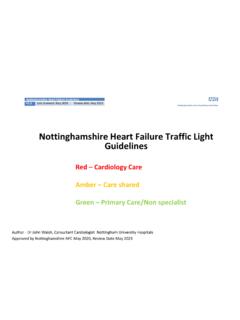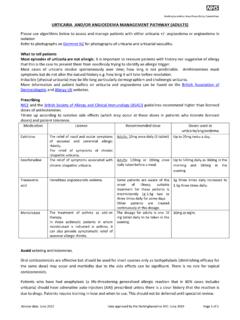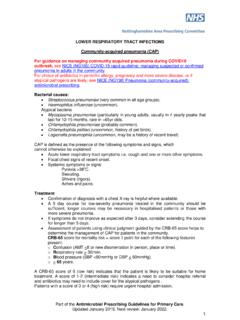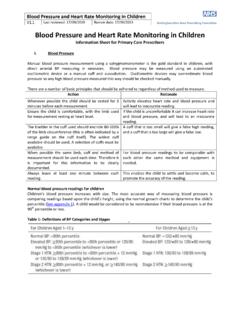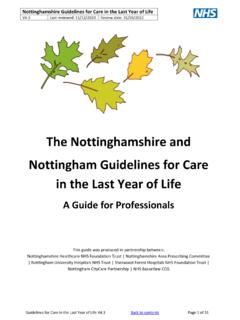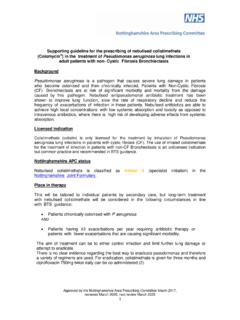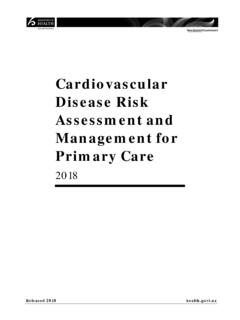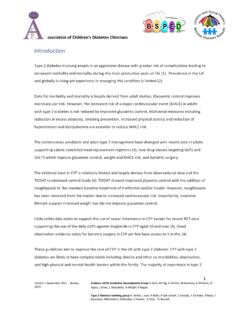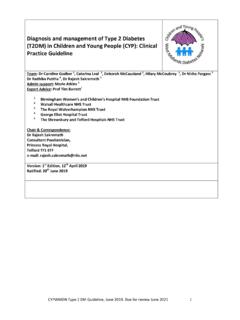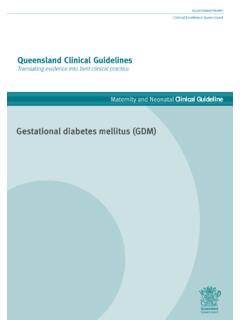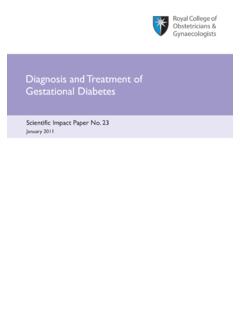Transcription of Management of Neuropathic Pain for Adults in Primary Care
1 Management of Neuropathic Pain for Adults in Primary Care Last reviewed: 19/08/2021 Review date: 19/09/2024 Management of Neuropathic Pain for Adults in Primary Care SCOPE This prescribing guideline is to assist Primary care prescribers in treating patients with Neuropathic pain BEFORE referral to specialist services. Contents Neuropathic PAIN TREATMENT PATHWAY .. 2 UNDERSTANDING Neuropathic PAIN .. 3 HOW COMMON IS Neuropathic PAIN? .. 3 RECOGNISING AND DIAGNOSING Neuropathic PAIN .. 3 PREVENTION & EARLY Management OF Neuropathic PAIN .. 4 Management .. 4 MANAGING EXPECTATION OF pharmacological TREATMENTS.
2 4 IMPROVING CONCORDANCE .. 5 REVIEW .. 5 CAUTIONS WITH Neuropathic PAIN THERAPIES .. 5 pharmacological OPTIONS FOR Management OF Neuropathic PAIN .. 6 Gabapentinoids .. 6 PAIN MEDICINES AND DRIVING .. 7 RESOURCES FOR CLINICIANS AND PATIENTS .. 9 REFERENCES .. 10 Management of Neuropathic Pain for Adults in Primary Care Page 2 of 11 Has there been a significant decrease in pain AND substantial increase in physical function? YES YES Neuropathic PAIN TREATMENT PATHWAY For Neuropathic pain offer a choice of either: Amitriptyline, Duloxetine, Gabapentin or Pregabalin as initial treatment.
3 Review at 6-8 weeks. Has there been a significant decrease in pain AND substantial increase in physical function? For trigeminal neuralgia offer Carbamazepine Review at 6-8 weeks. Has there been a significant decrease in pain AND substantial increase in physical function? Refer patient to specialist at any stage where the diagnosis is in doubt or patient is not responding to treatment. pharmacological Management See page 4 for information regarding realistic expectation of pharmacological Management . Ensure adequate doses are trialled for a long enough time before moving to the next step.
4 Do not continue ineffective treatment use short sequential trials or one medication at a time . Document baseline and set desired treatment out- comes prior to initiating therapies. See table on page 8 or refer to BNF and/or SPC for adverse effects and contraindications for specific medications. Non- pharmacological treatment options - Address common psychological co-morbidities ( anxiety/depression), consider referring/signposting to psychological therapies such as cognitive behavioural therapy * - If sleep is disturbed discuss sleep restoration strategies * - Physiotherapy - Interventional approaches such as surgery * Please see Clinicians Resources on page 9 for more information/options.
5 Other pharmacological treatment options to consider: Nortriptyline only use if amitriptyline effective but not tolerating side effects; off-label indication. Review at 6-8 weeks. Tramadol - Consider tramadol only if acute rescue therapy is needed. Review after 4 weeks. Capsaicin cream for localised pain due to post herpetic neuralgia. *Lidocaine 5% medicated plasters- for localised Neuropathic pain due to post herpetic neuralgia (PHN).Specialist pain team recommendation only. Consider Referral to Specialist Pain Management Service Maintain on medication and dose that is working. Review regularly NO NO NO STOP and try options below YES If the initial treatment is not effective or is not tolerated, offer one of the remaining 3 drugs, and consider switching again if the second drug tried is also not effective or not tolerated Management of Neuropathic Pain for Adults in Primary Care Page 3 of 11 UNDERSTANDING Neuropathic PAIN Neuropathic pain is very different from inflammatory pain.
6 Whilst nociceptive pain is produced by tissue damage Neuropathic pain is caused by a lesion or disease affecting the somatosensory nervous system which can result from nerve damage caused by trauma or certain conditions. HOW COMMON IS Neuropathic PAIN? Neuropathic pain is a common condition affecting between 6% and 8% of the population. An average GP may have between 35 and 70 patients with Neuropathic pain. Much Neuropathic pain can be successfully managed within Primary care. RECOGNISING AND DIAGNOSING Neuropathic PAIN Common causes of Neuropathic pain: Diabetes Mellitus (type 1 and 2) Shingles (Herpes Zoster) Trigeminal Neuralgia Post-Surgery post hernia repair Chronic spinal problems sciatica, neck pain, low back pain Underlying malignancy or other occult disease Consider referring patient to specialist setting if: The patient is experiencing severe pain.
7 Neuropathic pain is significantly limiting participation in daily activities (including self-care, general tasks and demands, interpersonal interactions and relationships, mobility, and sleeping). The underlying health condition that is causing Neuropathic pain has deteriorated. Emergency Urgent Non-Urgent Cauda equina syndrome Infection Metabolic causes alcohol excess or vitamin deficiency Cancer Phantom limb pain Trauma Post-surgery Medication toxicity chemotherapy Idiopathic Possible initial investigations if cause in doubt: ESR, CRP, fasting glucose, glucose tolerance test, LFTs, FBC, Vitamin B12 & folate, U&Es, TFTs Symptoms and signs of Neuropathic pain: Can be spontaneous or evoked; continuous or intermittent.
8 Is often worse at the end of the day. Can be exacerbated by heat, cold or external stimulation - even simply wearing clothes or bed sheets. History Listen to the person s pain story; this will help you to get a clear understanding of the person you are working with. Neuropathic pain may be characterized by unpleasant symptoms, such as: shooting or burning pain, altered sensation, sensations ( pins and needles) that are very difficult to describe or numbness Management of Neuropathic Pain for Adults in Primary Care Page 4 of 11 However, many pains, including pain arising from classically non- Neuropathic conditions ( osteoarthritis or cancer pain), can have Neuropathic characteristics.
9 Pain that is unresponsive to conventional analgesics (paracetamol, NSAIDs and weak opioids) may have Neuropathic elements. Consider use of a validated questionnaire ( S-LANSS or Pain Detect, see resources for clinicians) to aid diagnosis of Neuropathic pain. The Brief Pain Inventory (see resources for clinicians) is useful to assess pain intensity and the impact that the pain is having on daily living. Sensory signs Allodynia - pain produced by an innocuous stimulus touch, pressure, warmth Dysaesthesia - an unpleasant, abnormal sensation Hyperaesthesia - an increased sensitivity to touch Hyperalgesia - an increased response to a stimulus which is normally painful Associated symptoms and signs Reduced activity (65%) Poor sleep (60%) Depression (34%) Anxiety (25%) PREVENTION & EARLY Management OF Neuropathic PAIN Diabetes - Ensure optimal glycaemic control to minimise peripheral diabetic neuropathy.
10 Herpes zoster - Neuropathic pain medicines given in the acute phase may reduce post- herpetic neuralgia but are unproven. Management Management of Neuropathic pain should use a holistic biopsychosocial model that also addresses underlying psychological and social issues. If the diagnosis is uncertain consider early referral to a specialist. MANAGING EXPECTATION OF pharmacological TREATMENTS It is essential that prescribers and patients have realistic expectations for treatment. Development of self- Management skills (see Pain Toolkit) in combination with pharmacological treatment options is essential.

